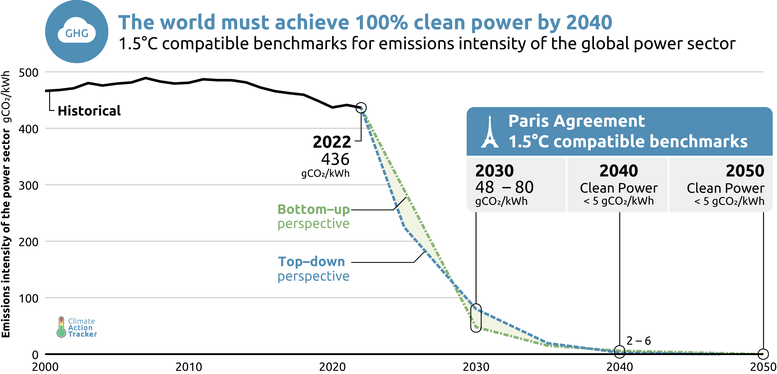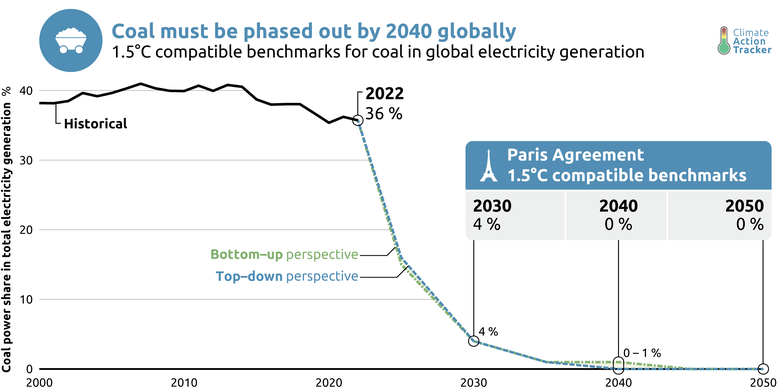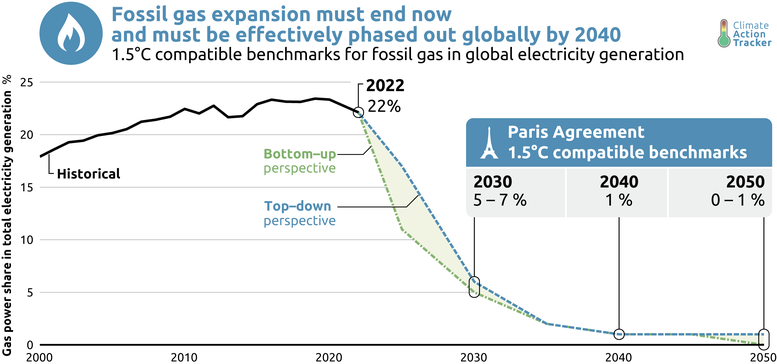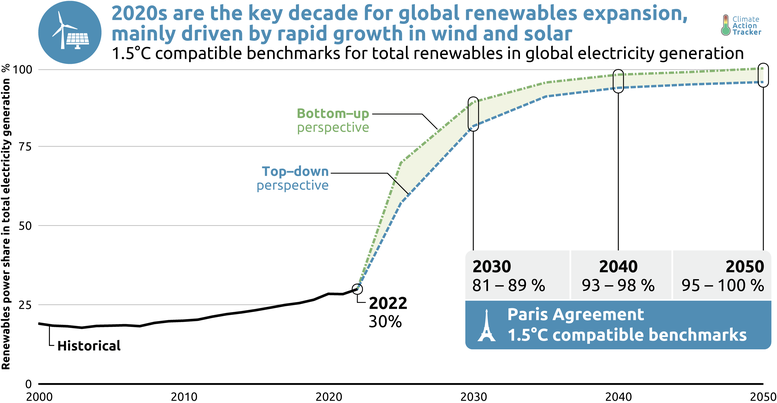Paris-aligned benchmarks for the power sector
Attachments
As the world moves to address the climate crisis and journey towards a zero-carbon future, roadmaps which demonstrate the pathway to cut emissions fast, fairly and effectively are essential.
The broad strokes of a Paris-aligned roadmap are clear – we need to roughly halve emissions by 2030, achieve net zero CO2 emissions by 2050 and net zero greenhouse gas emissions soon after. However, the details at the national and sectoral level need to be understood.
Wind and solar are ready to do the heavy lifting in the energy transition, but while positive signs can be seen in some countries, greater effort will be needed to accelerate renewables deployment. Countries are also continuing to build new coal and gas-fired power plants, representing a critical threat to the Paris Agreement.
New 1.5°C compatible benchmarks for the power sector
In this report, the Climate Action Tracker (CAT) provides new 1.5°C compatible benchmarks for the power sector, for the world as a whole and 16 countries, a mix of developed and developing. These are: Australia, Brazil, Chile, China, EU27, Germany, India, Indonesia, Japan, Mexico, Morocco, Türkiye, South Africa, the UAE, the UK, and the US.
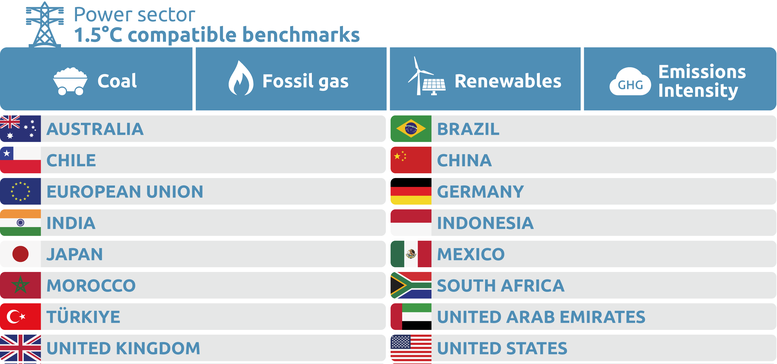
Our new benchmarks, based on our methodology, focus on what is needed to limit warming to 1.5°C and show how the shares of coal, fossil gas and renewables need to evolve out to 2050, and what this means for the emissions intensity of electricity generation, giving a roadmap for power sector decarbonisation. Many developing countries will need significant financial support to achieve the benchmarks set out in this report.
The world should aim to achieve clean electricity by 2040
The CAT finds that, to align with 1.5°C, the world should aim to achieve clean electricity by 2040 – within a generation’s time – and to support each other to jointly meet these goals.
Developed countries should take the lead, phasing out coal by 2030 and unabated fossil gas by 2035.
While the pace of action could be slower in developing countries than in wealthier nations, they should still aim to eliminate coal and unabated fossil gas from electricity generation by 2040.
Global coal phase out by 2040
Phasing out coal-fired power generation remains a critical step to limiting warming to 1.5ºC. In 2022, burning coal for electricity generation produced 8.4 GtCO2e of greenhouse gas emissions, around two-thirds of power sector emissions. Coal-fired power generation is also responsible for large levels of air pollution, and a coal phase-out would bring considerable health and economic benefits alongside reducing emissions.
For 1.5ºC, the world must phase out coal by 2040, reducing its share from 36% in 2022 to 4% in 2030, ultimately reaching 0% in 2040. This requires that coal-fired power generation falls 87% from 2022–2030. There is no room to expand coal-fired generation in 1.5ºC compatible pathways.
End fossil gas expansion and effectively phase out fossil gas power by 2040
Global gas-fired power generation grew strongly from 2000 until 2020, reaching 23% of total generation in 2020. In our 1.5°C compatible benchmarks, the share of electricity produced by fossil gas falls to 5–7% by 2030, 1% by 2040, and reaches 0–1% by 2050.
The CAT provides benchmarks for total fossil gas generation, rather than focusing only on unabated gas generation. The role of fossil CCS in a decarbonised power sector is either minimal or zero entirely.
Deployment of renewables must accelerate
A 1.5°C aligned power sector transition will be driven by renewables, particularly wind and solar. By 2030, the global share of renewables reaches 81–89% in 1.5°C-compatible pathways, growing to 93–98% by 2040 and 95–100% by 2050.
While renewables deployment is beginning to accelerate, there is still an important ambition gap in 2030 that needs to be closed. At current rates, the world is on track to achieve around 50% renewable electricity by 2030.
Fossil fuel pipeline remains
Worryingly, countries are continuing to build new coal and gas-fired power plants, representing a critical threat to the Paris Agreement. There is currently 558 GW of coal either planned or under construction across the world. The pipeline is even bigger for fossil gas with around 790 GW of fossil gas-fired plants either under construction or proposed. Unlike coal where it is centered almost entirely in China, India and Indonesia, the dash for gas is global, with almost all countries planning on building new fossil gas plants.
The CAT also finds that carbon capture and storage (CCS) will play, at best, a minor role in the power sector. While contemporary model-based assessments include small levels of fossil gas equipped with CCS post-2040, they also show that CCS would provide at most 1% of global electricity generation – a negligible amount. Given the rapid cost reductions in renewables and storage that are not yet fully reflected in models, there are strong grounds to believe that fossil CCS would have virtually no role in the future power sector.
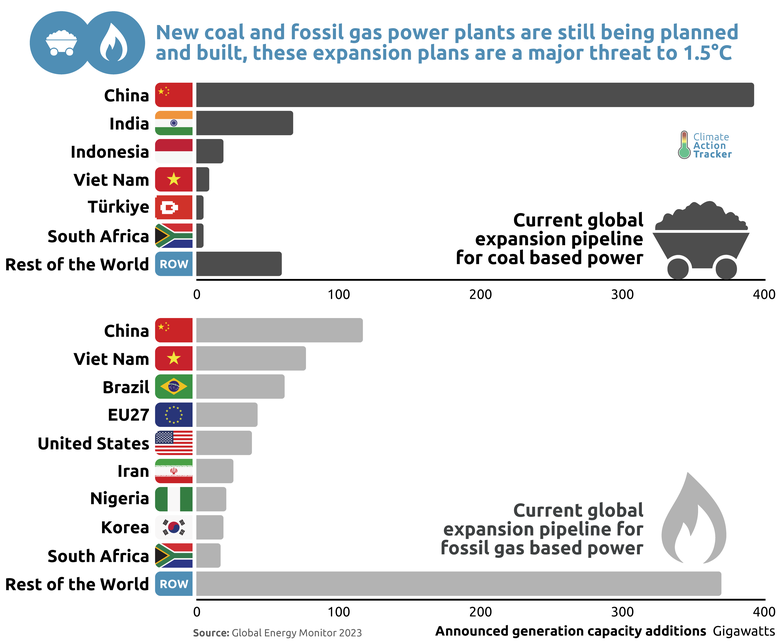
CAT analysis based on Global Energy Monitor data
The roadmap is clear
The need for a rapid transition away from fossil fuels and towards renewables in the power sector remains as urgent as ever. The roadmap is clear and the path ahead is achievable. What remains to be seen is whether governments will deliver the policies and investments needed to achieve clean electricity by 2040 and lay the foundations of a zero-carbon future for all.
The future does not have to look like the past, but this will only happen if our future efforts to address climate change break markedly from past efforts. This will require greater action to support renewables deployment, coupled with a clear commitment to end building new fossil-fired power plants and phase out coal and gas in power generation.
Stay informed
Subscribe to our newsletter
